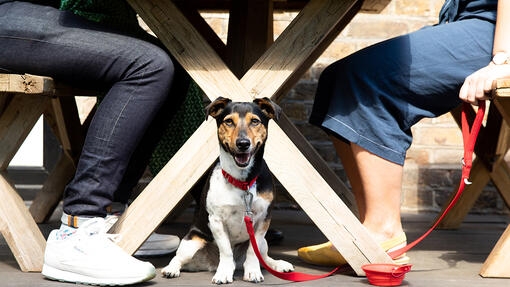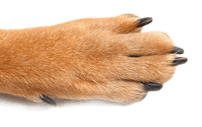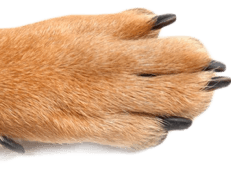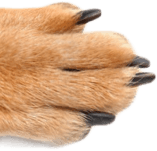
Explore ways to teach your dog or puppy to be calm, relaxed and settle. Provide an outlet for their natural exuberance and energy so they are able to be calm and relaxed. Teach your dog how to settle in different places when you need them to.
While we love our dog’s natural enthusiasm for life, it is important that and the end of the day, they can be calm and relaxed at home. This is one of the important life skills that all companion dogs need to learn – and all owners need to understand.
Why can some dogs struggle with being relaxed and calm?
Before thinking about how to train your dog to be calm and relaxed, it is important to be realistic about what you are asking – and look on this as a part of your dog’s day to day routine.
Many of our most beloved dog breeds were designed to be tireless workers. The gundogs, the pastoral dogs, the working dogs and the terriers were all created to work all day every day, and as such have a lot of energy and are very much ‘on the go’. This is what they are going to be like to live with whether we like it or not.
They need an outlet for all that energy in the form of appropriate exercise, enrichment, play and social company – every single day. Without that, they are going to become bored, frustrated, or just have way too much pent-up canine energy. No dog who feels like that is going to be able to relax! In contrast, a dog who has all the appropriate exercise and enrichment can easily be taught to be calm and relaxed at the end of the day – in fact it will come naturally.
Over-exercise
The other side of that coin however is that owners of active dogs often try to tire them out in the mistaken belief that if they get their dog tired enough with exercise and maybe endless ball throwing, they might actually sleep! The problem is that the opposite is true. Exercise makes you fitter. That’s why we go to the gym, do yoga, run marathons etc. By giving your dog more active exercise with the aim of exhausting them, you will just turn them into a canine athlete who needs more and more exercise to be happy – and who expects that much exercise – so relaxation becomes impossible.
Inappropriate exercise
As for endless ball throwing, this is not natural for a dog. Yes, dogs chase things naturally and it taps into their hard-wired dog behaviour patterns, as it is what their ancestors would have done to catch prey for dinner, but this would only be one or two chases followed by a rest and probably a meal. Repetitive high-energy chasing increases your dog’s arousal and adrenaline levels which can take hours to return to normal. It can also cause pain and/or lasting injuries – especially in young dogs or older ones.
Ball throwing and retrieve games can be a part of your exercise and play time with your dog but in moderation, not as an attempt to tire them out.
Age
Just like humans, younger dogs are more active. They have all the energy and enthusiasm of youth that they don’t always know how to control - and that can come out in all kinds of bouncy, overly enthusiastic, slightly crazy ways.
Puppies have loads of energy in short bursts. They will charge around, play and get excited – and then crash and snooze. A young puppy needs to sleep for around 18 hours a day and without that, they can become over-tired and fractious, and so struggle with being relaxed.
Unpredictable routine
Dogs need consistency from their owners or guardians – relaxation and calmness come from predictability and knowing that their needs will be met.
Just like humans, being calm and relaxed isn’t something you ‘train’ or can force – it is something your dog ‘is’ as a result of the environment you create around them.
Step by step guide to helping your puppy or dog relax
- Make sure they are getting all the exercise and enrichment they need throughout the day. This includes outlets for their natural behaviours, play and social company. Most dogs who get these outlets reliably and predictably, are only too happy to relax and chill at the end of the day.
- Have a reliable routine that includes exercise, enrichment, play, food and sleeping. This is especially important for puppies. If a dog has predictability in their day, they learn the times when exciting things are going to happen (like walks) and so can more easily relax the rest of the time as they are not constantly on edge wondering if something interesting could be about to happen any moment.
- Make sure your dog has somewhere comfortable to lie in every room you want them to relax with you in. Place it close to where you sit so, they feel that they are chilling with you.
- Spend time each day with your dog doing very little in a quiet room in the house. Sit and read, or binge watch your favourite new series. Give your dog something to do that is rewarding but calm such as lick mats or snuffle mats. Make this relaxation time a part of every day.
- Make many of your walk's quiet ones rather than high energy ones – but they still need to be enriching ones where your dog uses their brains. This could mean a sniffari or other sniffing/scenting exercise. It could include training exercises like sits, downs, stays, or it could be hide and seek type exercises hunting out a favourite toy you have hidden. Think of ways to use their brains to use up their energy not high-octane activities that will leave their brains fizzing and make it impossible for them to settle.
- Do more enrichment/problem solving games in the house or the garden. These can be shop bought puzzles (such as food dispersing toys or games where your dog has to use their mouth, paws or nose to find treats) or ones that you make yourself from household objects. Something as simple as some treats folded into an empty kitchen rolls tube can make a good starting point.
- Do five minutes of indoor training a couple of times a day. Given your dog a chance to use their brain working with you – as that is often more tiring (especially for young or adolescent dogs) than charging around.
- Be boring on occasions. Don’t feel you have to keep your dog occupied every second of every day. Get them used to just hanging out with you.
Training your puppy or dog to settle
While you want your dog to be calm and relaxed when you are chilling at home, there will be times when you want them to settle as a training exercise. This might be if you are visiting friends, going out for a coffee or to the pub, or if you just want some peace to watch TV or work.
What you need:
- A blanket or mat that is portable (so you can take it other places you might want your dog to settle)
- Treats
- A long training lead (with clips at both ends) and harness
- When you know your dog is able to relax – so has had exercise, food and been to the toilet – put the mat on the floor beside where you are going to be sitting.
- Doing this with your dog’s harness on and a long training lead will prevent them wandering off, as you can attach the lead to the bottom of your chair. This should be loose – you are not trying to restrict them or ‘tie them in place’ but you are reducing their choices to make it more likely that they decide to lie down and settle!
- Sit down, pick up your book or turn on the TV.
- ‘Ignore’ your dog – while of course keeping an eye on them!
- When your dog stands on the mat (even if accidentally), drop a treat on to the mat. You are aiming to build up positive associations with being on the mat.
- Once they get the idea of standing on the mat for a reward, only reward them if they sit – or better still lie down – on the mat. If they wander off, bark, scratch etc, ignore them until they put a paw back on the mat. You are teaching them that when they choose to relax on the mat, you will reward them.
- Enjoy your book or TV – remembering to reward your dog from time to time for being calm by dropping a treat on the mat.
- Only do this for a few minutes to start with – but with time you can build up the duration as your dog gets more relaxed and more likely to snooze off.
- Once your dog is an expert at doing this, you can do it in various rooms and even in the garden.
- Once perfected, you can take the mat with you when you go out and have your dog chill out on it in various environments where your dog is happy to be.
- Like most exercises, this is only one way to teach it. You can put the mat down, lure the dog onto it and ask them to lie down and reward them – and then build up the duration, or else you could put down a toy full of food for them to gnaw on - but it is far better that your dog learns that when you relax, the best thing for them to do is spontaneously relax with you.
Understanding Your Dog's Needs When You’re Out and About
When it comes to going out and about however, think about whether what you are asking is right for your dog. Not all dogs are social butterflies and many are homebodies who find novelty stressful. Just because you want to take your dog to the pub or a busy coffee shop, doesn’t mean that it is a good environment for your dog. Some absolutely love it, whereas for others, the sights, sounds, smells and movement of people and things around them are totally over-stimulating or scary and can result in reactivity or fear. Never forget that your dog is a dog – not a small person in fur coat!
With a combination of good management, routine and life skill training, you can ensure your dog is active and enthusiastic when you want them to be, and able to chill out and relax at the end of a busy day.




